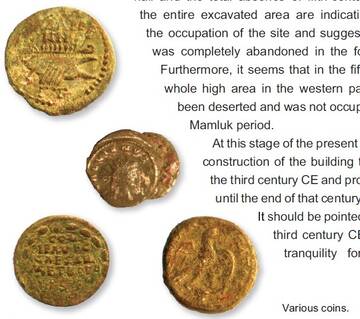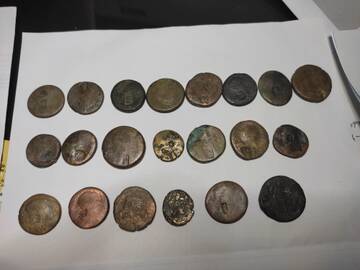Уважаемые форумчане!
В брошюре о раскопках в районе лагеря Шестого Железного легиона в израильском Мегиддо упомянули находки монет.
Вот этот текст:
More than one hundred coins were recovered from the excavations in Area Q. Of these about a third date to the second–third centuries CE, 60%—to the fourth century CE, and the rest relate to later periods. Twenty-eight coins of the second–third centuries CE were collected from the building housing the Christian prayer hall, whereas most of the fourth century CE coins were found east of the building and south of the alley, on occupation levels dating to the Late Roman and Byzantine periods. Notable among the former were well-worn coins from the second century CE and the early third century CE, and others, in pristine condition, dating to the reigns of Elagabalus (218–222 CE) and Severus Alexander (222–235 CE). These coins should probably be associated with the founding of the building.
The numismatic evidence from the occupation period of the building consisted of city coins dating to the time of Gordianus III (238–244 CE) and imperial coins (antoniniani) from the reigns of Valerianus and Gallienus in the sixth and seventh decades of the third century CE. The latest coin dated to the reign of Diocletian in the late third century CE and represented the last phase of the building’s use.
A tetradrachma from the time of Macrinus (217–218 CE) was in use for a relatively long time, probably due to its high value.
The absence of fourth-century-CE coins from the building housing the prayer hall and the total absence of fifth-century-CE coins from the entire excavated area are indicative of a hiatus in the occupation of the site and suggest that the building was completely abandoned in the fourth century CE. Furthermore, it seems that in the fifth century CE the whole high area in the western part of the site had been deserted and was not occupied again until the Mamluk period.
At this stage of the present study, we date the construction of the building to the first third of the third century CE and propose it was in use until the end of that century, at the very latest. It should be pointed out that the early third century CE was a period of tranquility for the Christians, which allowed the churches to flourish. This calm was cut short with the death of Severus Alexander and the ascension of Maximinus (235–238 CE), who persecuted the Christians, although targeting only their clergy.
Он иллюстрирован картинкой:
Вопрос: можно определить, какие монеты из упомянутых в тексте изображены на картинке?
Насколько эти монеты редки и есть ли возможность приобрести аналогичные сейчас?
Заранее спасибо!



 )
)
